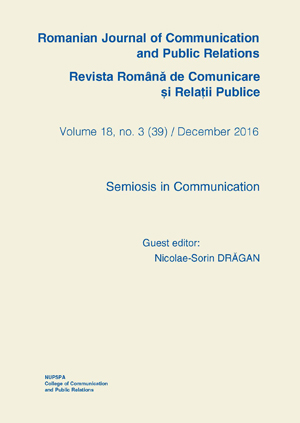Visual Metaphors in Communication: Intertextual Semiosis and Déjà Vu in Print Advertising
Visual Metaphors in Communication: Intertextual Semiosis and Déjà Vu in Print Advertising
Author(s): Evripides ZantidesSubject(s): Semiology, Communication studies
Published by: Editura Comunicare.ro
Keywords: visual metaphors; intertextuality; semiotics; advertising; logos
Summary/Abstract: Metaphor, as a concept in which a signified is applied to a signifier that is not literally applicable, does not only refer to speech or verbal language, but also to a wide use of practical applications in visual communication, particularly in advertising design and communication. The metaphorical rhetoric in advertisements is a common practice often used to attract the viewers’ attention, as well as enhance the persuasiveness of messages. From a cognitive perspective, semiosis in the process of visual metaphors in communication, is a complex subject with often a variety of subjective interpretations on behalf of the viewers. Intertextuality, as another form of metaphoric communication that depends on pre-existingtexts (verbal or non-verbal), produces meanings that often deal with parody, sarcasm or irony. Additionally, they are also frequently characterised as anarchistic and provocative, because of the anti-advertising or anti-consumerism/social statements they make.The current study aims to present a literature review on how visual metaphors are defined in printa dvertising, and build on this to examine the notion of intertextuality as a form of déjà vu-metaphor that is popular in advertising and graphic communication.Semiotic analysis as a methodology is used on a purposive sample of print advertisements—including examples of logotypes as well—in order to categorize thematically the major typological references, in respect of intertextual advertising, as well as extract ideological conclusions.The results show that intertextuality in advertising draws its sources of meaning mainly from the Film industry, Art, Monuments and places, Literary texts and Graphic and Advertising itself, whilst, as far as logos is concerned, the source of meaning is purely linguistic. The study also shows that Intertextual visual metaphor semiosis has a variety of popular verbal or non-verbal references and depends on the socio-political context of the sample under investigation.
Journal: Revista Română de Comunicare şi Relaţii Publice
- Issue Year: 18/2016
- Issue No: 3
- Page Range: 65-74
- Page Count: 10
- Language: English

